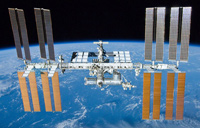The first part of the ISS sent to space was the module called Zarya. It was launched into space on a Russian Proton rocket on November 20th, 1998. Zarya provided propulsion, attitude control, communications and electrical power.
Two weeks later, NASA launched a module called Unity aboard Space Shuttle Endeavour, successfully attaching it to the Zarya module. The Unity module was equipped with all the requirements for long-term human living.
The ISS was built to be a space environment research laboratory and observatory, where crew members could conduct experiments in many scientific fields including: biology, human biology, physics, astronomy, and meteorology.
The first ISS crew mission called 'Expedition 1' launched on a Russian Soyuz, October 31, 2000. The 3 Russian cosmonauts docked and entered the ISS on November 2nd, 2000. The space station has been continuously occupied since, making it the longest continuous human presence in space.
The ISS has been visited by astronauts and cosmonauts from 15 different nations. There has been a total of 352 flights to the ISS, by 211 individual people, 31 of these were women, and 7 were 'space tourists' (as of 2013).
As of 2013, there has been 174 spacewalks outside the modules in support of the ISS's construction and maintenance, that's almost 1,100 hours (nearly 46 days). There's been 38 expeditions to the ISS as of 2013. An expedition can last up to six months. Early expeditions had 3 person crews, this was reduced to 2 person crews for safety, however today crew numbers regularly reach 6 people.
The ISS programme is a joint project that involves 5 space agencies. NASA, of USA, Roskosmos of Russia, JAXA of Japan, CSA of Canada and ESA made up of agencies from France, Brazil, Malaysia, South Korea and Italy.
With the naked eye, the ISS can be seen from nearly every area of Earth at some point in time, it appears as a slow moving bright white dot in the night sky. For more information about how astronauts do everyday tasks in zero gravity on the ISS, see our amazing Astronauts Videos page!
| | |  | | More Space Facts: | | | | | | | | | | | | | | | | Space Station Facts | | | |
|